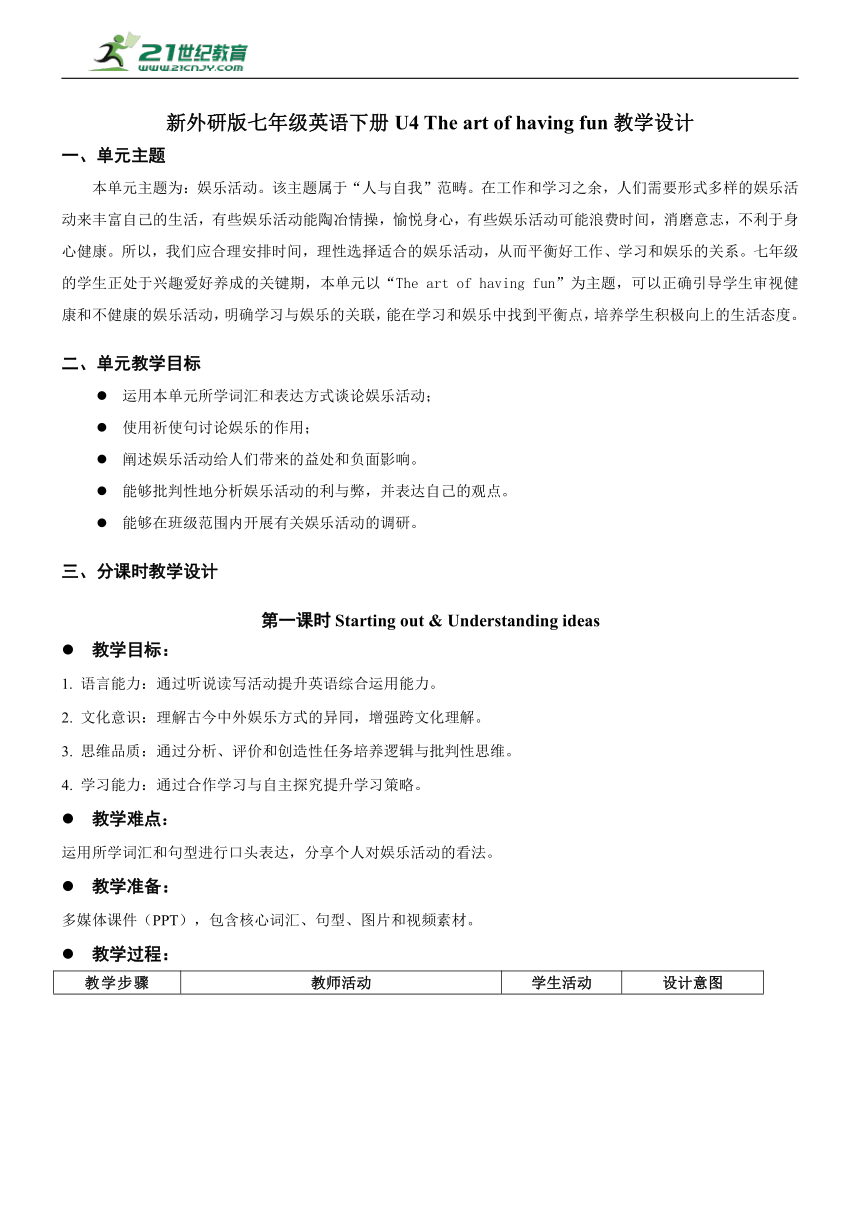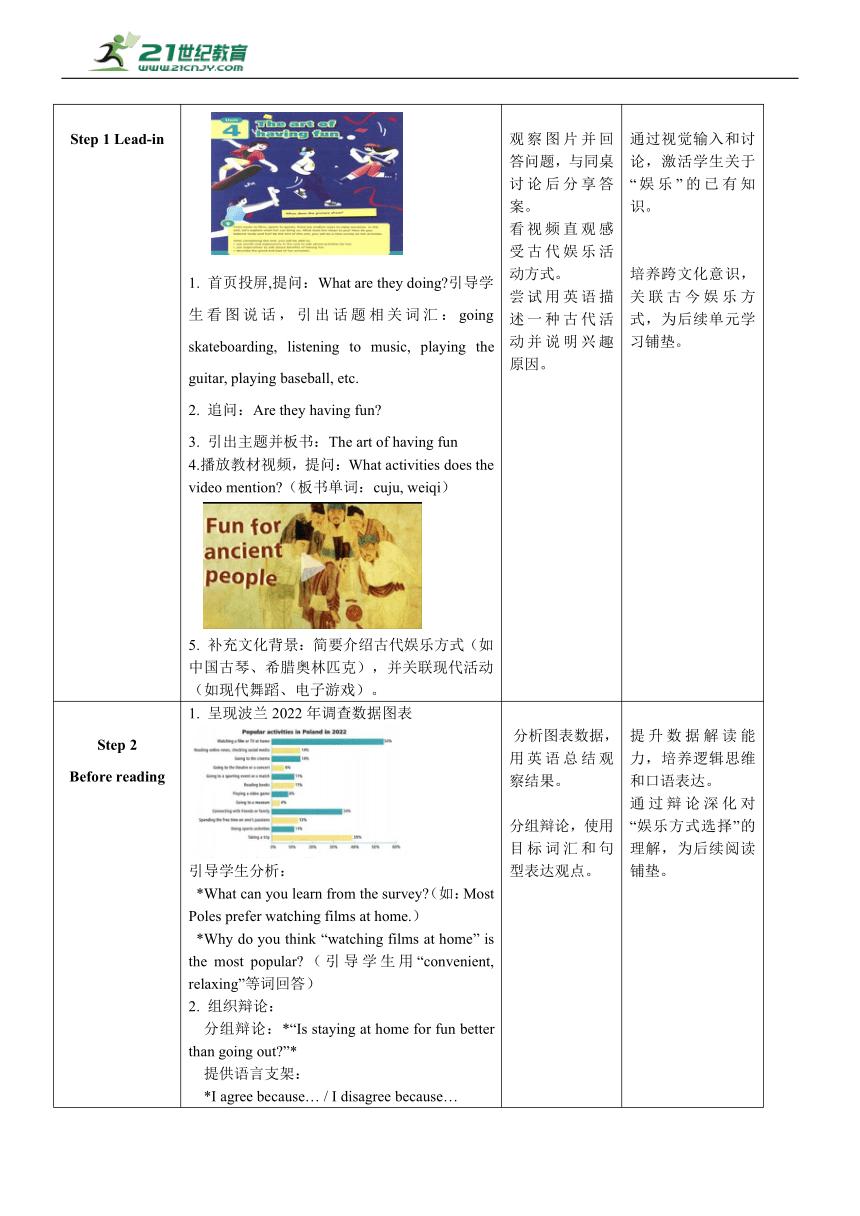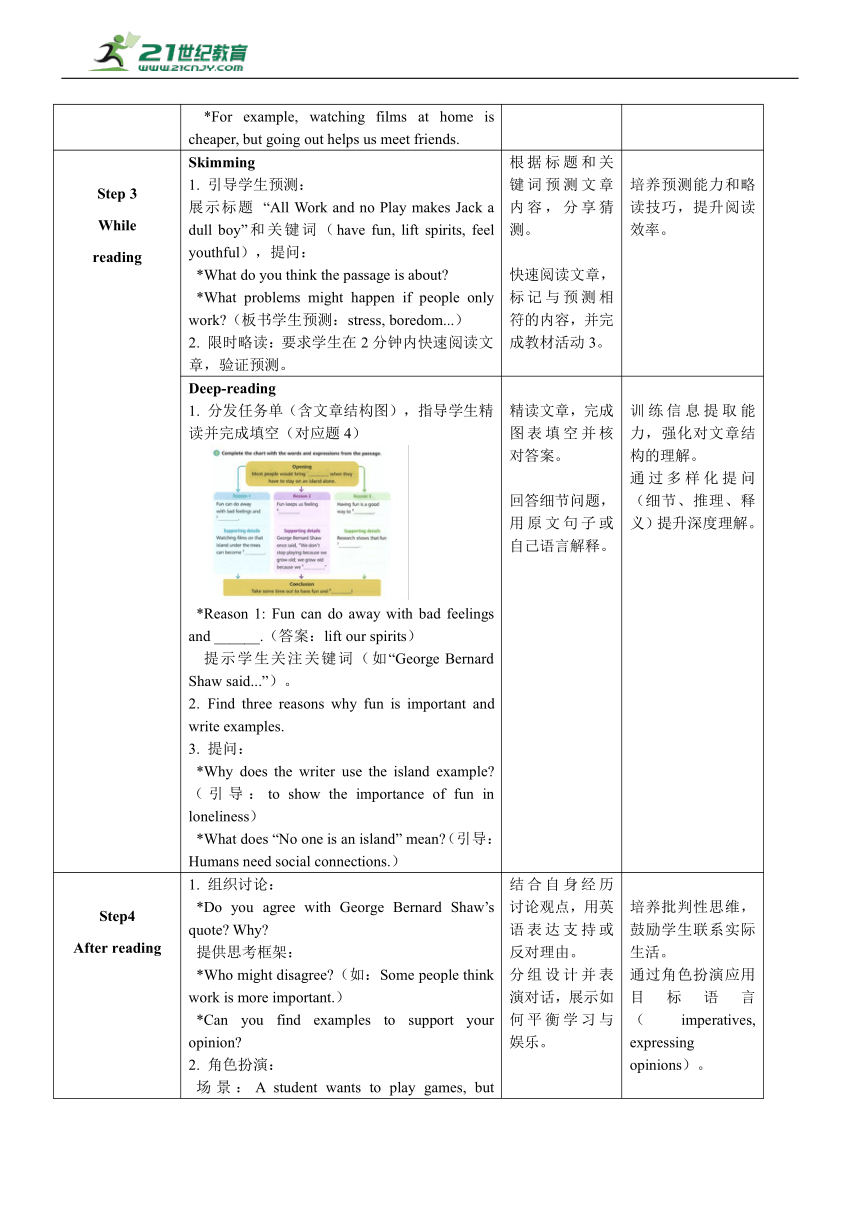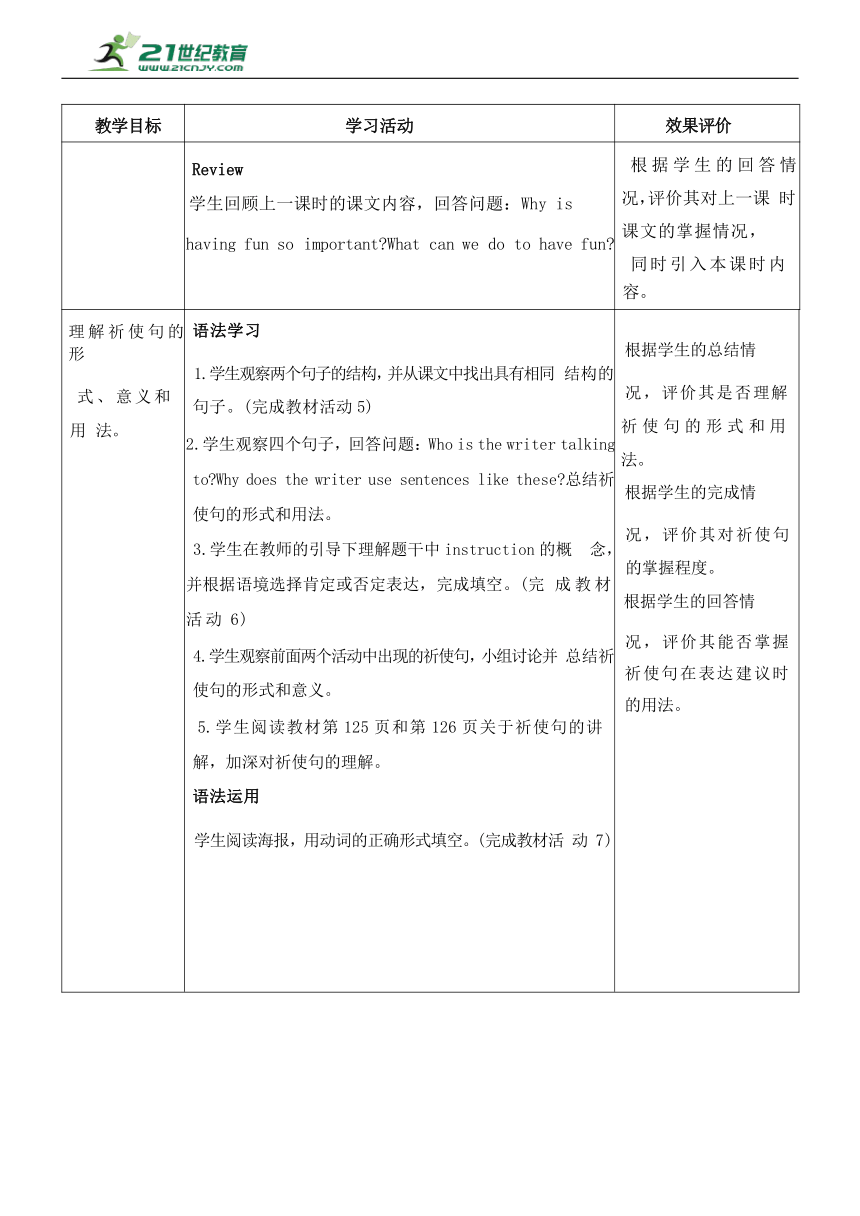Unit 4 The art of having fun表格版课时教学设计【2025新外研版七年级英语下册】
文档属性
| 名称 | Unit 4 The art of having fun表格版课时教学设计【2025新外研版七年级英语下册】 |  | |
| 格式 | docx | ||
| 文件大小 | 941.7KB | ||
| 资源类型 | 试卷 | ||
| 版本资源 | 外研版 | ||
| 科目 | 英语 | ||
| 更新时间 | 2025-03-21 06:31:44 | ||
图片预览





文档简介
新外研版七年级英语下册U4 The art of having fun教学设计
一、单元主题
本单元主题为:娱乐活动。该主题属于“人与自我”范畴。在工作和学习之余,人们需要形式多样的娱乐活动来丰富自己的生活,有些娱乐活动能陶冶情操,愉悦身心,有些娱乐活动可能浪费时间,消磨意志,不利于身心健康。所以,我们应合理安排时间,理性选择适合的娱乐活动,从而平衡好工作、学习和娱乐的关系。七年级的学生正处于兴趣爱好养成的关键期,本单元以“The art of having fun”为主题,可以正确引导学生审视健康和不健康的娱乐活动,明确学习与娱乐的关联,能在学习和娱乐中找到平衡点,培养学生积极向上的生活态度。
二、单元教学目标
运用本单元所学词汇和表达方式谈论娱乐活动;
使用祈使句讨论娱乐的作用;
阐述娱乐活动给人们带来的益处和负面影响。
能够批判性地分析娱乐活动的利与弊,并表达自己的观点。
能够在班级范围内开展有关娱乐活动的调研。
三、分课时教学设计
第一课时Starting out & Understanding ideas
教学目标 :
1. 语言能力:通过听说读写活动提升英语综合运用能力。
文化意识:理解古今中外娱乐方式的异同,增强跨文化理解。
思维品质:通过分析、评价和创造性任务培养逻辑与批判性思维。
学习能力:通过合作学习与自主探究提升学习策略。
教学难点 :
运用所学词汇和句型进行口头表达,分享个人对娱乐活动的看法。
教学准备 :
多媒体课件(PPT),包含核心词汇、句型、图片和视频素材。
教学过程:
教学步骤 教师活动 学生活动 设计意图
Step 1 Lead-in 首页投屏,提问:What are they doing 引导学生看图说话,引出话题相关词汇:going skateboarding, listening to music, playing the guitar, playing baseball, etc. 追问:Are they having fun 引出主题并板书:The art of having fun 4.播放教材视频,提问:What activities does the video mention (板书单词:cuju, weiqi) 5. 补充文化背景:简要介绍古代娱乐方式(如中国古琴、希腊奥林匹克),并关联现代活动(如现代舞蹈、电子游戏)。 观察图片并回答问题,与同桌讨论后分享答案。 看视频直观感受古代娱乐活动方式。 尝试用英语描述一种古代活动并说明兴趣原因。 通过视觉输入和讨论,激活学生关于“娱乐”的已有知识。 培养跨文化意识,关联古今娱乐方式,为后续单元学习铺垫。
Step 2 Before reading 呈现波兰2022年调查数据图表 引导学生分析: *What can you learn from the survey (如:Most Poles prefer watching films at home.) *Why do you think “watching films at home” is the most popular (引导学生用“convenient, relaxing”等词回答) 2. 组织辩论: 分组辩论:*“Is staying at home for fun better than going out ”* 提供语言支架: *I agree because… / I disagree because… *For example, watching films at home is cheaper, but going out helps us meet friends. 分析图表数据,用英语总结观察结果。 分组辩论,使用目标词汇和句型表达观点。 提升数据解读能力,培养逻辑思维和口语表达。 通过辩论深化对“娱乐方式选择”的理解,为后续阅读铺垫。
Step 3 While reading Skimming 1. 引导学生预测: 展示标题 “All Work and no Play makes Jack a dull boy”和关键词(have fun, lift spirits, feel youthful),提问: *What do you think the passage is about *What problems might happen if people only work (板书学生预测:stress, boredom...) 2. 限时略读:要求学生在2分钟内快速阅读文章,验证预测。 根据标题和关键词预测文章内容,分享猜测。 快速阅读文章,标记与预测相符的内容,并完成教材活动3。 培养预测能力和略读技巧,提升阅读效率。
Deep-reading 分发任务单(含文章结构图),指导学生精读并完成填空(对应题4) *Reason 1: Fun can do away with bad feelings and ______.(答案:lift our spirits) 提示学生关注关键词(如“George Bernard Shaw said...”)。 Find three reasons why fun is important and write examples. 3. 提问: *Why does the writer use the island example (引导:to show the importance of fun in loneliness) *What does “No one is an island” mean (引导:Humans need social connections.) 精读文章,完成图表填空并核对答案。 回答细节问题,用原文句子或自己语言解释。 训练信息提取能力,强化对文章结构的理解。 通过多样化提问(细节、推理、释义)提升深度理解。
Step4 After reading 1. 组织讨论: *Do you agree with George Bernard Shaw’s quote Why 提供思考框架: *Who might disagree (如:Some people think work is more important.) *Can you find examples to support your opinion 2. 角色扮演: 场景:A student wants to play games, but parents say “Study first!” 分组表演对话,使用目标句型: *I think… because… / Let’s balance… 结合自身经历讨论观点,用英语表达支持或反对理由。 分组设计并表演对话,展示如何平衡学习与娱乐。 培养批判性思维,鼓励学生联系实际生活。 通过角色扮演应用目标语言(imperatives, expressing opinions)。
Step 5 Homework 1. 调查家人或朋友: - 问题:*What do you do for fun How does it help you - 记录至少3人的回答(表格形式)。 2. 撰写报告: - 用英语总结调查结果(例:My mom watches dramas to relax; my friend plays basketball to stay healthy...)。 - 分析:What is the most popular way to have fun Why 将课堂内容延伸到实际生活,培养社会调查能力。 通过数据整理和分析提升逻辑思维与表达能力。
7BU4 The art of having fun
第二课时Grammar Rules 祈使句教学设计
教学目标
语言知识目标:
掌握祈使句的基本结构和用法。
理解并运用祈使句表达请求、命令、建议等。
2. 语言技能目标:
能够运用祈使句进行简单的对话和交流。
能够运用祈使句编写简单的指令或规则。
3.学习策略目标:
通过观察、归纳和总结,掌握祈使句的用法。
通过小组合作学习,提高学习效率。
4. 情感态度目标:
培养学生学习英语的兴趣和积极性。
引导学生礼貌地表达请求和建议。
二、教学重点
祈使句的基本结构和用法。
祈使句的肯定形式和否定形式。
三、教学难点
祈使句的语调。
祈使句在不同语境中的运用。
四、教学过程
教学目标 学习活动 效果评价
Review 学生回顾上一课时的课文内容,回答问题:Why is having fun so important What can we do to have fun 根据学生的回答情 况,评价其对上一课 时课文的掌握情况, 同时引入本课时内 容。
理解祈使句的形 式、意义和用 法。 语法学习 1.学生观察两个句子的结构,并从课文中找出具有相同 结构的句子。(完成教材活动5) 2.学生观察四个句子,回答问题:Who is the writer talking to Why does the writer use sentences like these 总结祈使句的形式和用法。 3.学生在教师的引导下理解题干中instruction的概 念,并根据语境选择肯定或否定表达,完成填空。(完 成教材活动6) 4.学生观察前面两个活动中出现的祈使句,小组讨论并 总结祈使句的形式和意义。 5.学生阅读教材第125页和第126页关于祈使句的讲 解,加深对祈使句的理解。 语法运用 学生阅读海报,用动词的正确形式填空。(完成教材活 动7) 根据学生的总结情 况,评价其是否理解 祈使句的形式和用 法。 根据学生的完成情 况,评价其对祈使句 的掌握程度。 根据学生的回答情 况,评价其能否掌握 祈使句在表达建议时 的用法。
谈论娱乐活动的 重要性,并运用 祈使句就如何享 受娱乐活动提出 建议。 1.学生思考娱乐活动的重要性,随后在班上分享自己的 看法,并就如何享受娱乐活动提出建议。学生可使用本 单元已学词汇和祈使句回答问题:Is it necessary to set up clubs at school Why is it important to have fun What advice would you like to give on having fun 2.学生两人一组进行对话,交流所学内容,同时记录关 键信息。(完成教材活动8) 3.学生思考并回答问题:How much time should we spend on studying and having fun 根据学生的回答情 况,评价其能否运用 本单元的核心语言知 识表达娱乐活动的重 要性并提出建议。 根据学生的回答情 况,评价其能否理解 本单元的第一个子话 题:娱乐活动的益处。
五、Summary and Homework
1.总结本课所学语法知识
2.Write about your discussion with your partner,including the importance of having fun and your advice on having fun.
3.小组活动:学生两人一组,根据图片或提示词进行对话,使用祈使句表达请求、命令或建议。
7BU4 The art of having fun
第三课时Developing ideas
Analysis of the learning material:
This is a news report. Chinese expert Zhao li set a new Guinness world record by finding the world’s largest mosquito. He spends his life finding and protecting insects.
Teaching objectives
By the end of this class, students will be able to:
1)try to learn how to show your opinion about interest.
2)use the words and expressions in this unit to talk about a person who makes an interest into a lifelong career.
Key words:
discover, set a new record, find, the world ' s largest mosquito, big, long, protect, interest in insects, enjoy, study, challenging , used to ..., take photos of ..., butterfly , give ... so much joy , set up a museum , encourage , prince , an insect lover
Important points:
Try to pay attention to listening, find out some information and get the main idea.
Try to learn some skills of listening. listen for connected words and expressions.
Teaching process:
Step1.lead-in
Let students look at the picture, and ask students what can you see in the picture
( A mosquito and a Guinness World Record certificate .)
Q2:What do you know about Guinness World Records ?
To lead students to focus on DID YOU KNOW ?
It covers achievements like the quickest marathon time or the biggest mosquito.
(Achievement means great things someone has done )
Q3:What is special about the insect
( It ' s the biggest mosquito in the world .)
引导学生细读证书上的文字。由于生词较多,可以鼓励学生利用词典查询 specimen , crane - fly , belong to , species , measure 等词和短语的含义。
Step2.listening
Before listening: look through Activity 1,understand the three sentences and underline key words of each sentence. 引导学生预选一个选项。
Q: Who set this Guinness World Record How did he make it ?Let’s listen and find the answer.
While listening: play the tape, and finish Activity 1.
如果学生基础较弱,可以再播放一遍。
Q:What achievements did Zhao Li make ?
Listen again and finish the mind map in Activity 2.
1.read the listening material together.
This is Great world. Here is today's news. Chinese expert ZhaoLi set a new Guinness world record by finding the world's largest mosquito. It's very big, over 11 centimeters in wingspan and about 26 centimeters long. ZhaioLi is the director of the insect museum of west China in Chengdu. He spends his life finding and protecting insects. The mosquito is in the museum now for every insect lover to see.
2.Pair work: answer the questions.
(1) Who is Zhao Li
(2) What is Zhao Li ' s job
(3) What is Zhao Li ' s interest
(4) What is the mosquito like
3.discuss and share:
What do you learn from people who make their interest into a career?
4.listen to an interview
Answer the questions and fill in blanks.(完成教材活动 3)
学生第二次听音频,根据学生的作答情况,评价其对听力文本大意的理解是否准确,核对听前预测和实际听取的信息,评价其与听前预测是否一致。
5.学生关注 Learning to learn 部分的内容,理解听前预测、听取细节的方法。
6.学生回答问题:How does the interviewer change the subject Can you think of some key words or sentences 学生关注 Learning to learn 部分的内容,尝试理解采访者转换话题的方法。学生再次听音频,找出采访者转换话题的表达方式。
7.学会使用过度语言 “Now, we are going to...; Next...”学生关注教材第 102 页的 Useful expressions, 掌握转换话题的表达方式。
After listening:
1.学生分享,分享对他们的了解,简单描述其中一人的兴趣发展过程。
2.讨论两位人物的经历,学生两人一组,讨论问题:How did they make an interest into a lifelong career What do you learn from them?(完成教材活动4)用上目标语言“Now, we are going to...; Next...”
Step3. Homework
1. must do: draw a mind map to review what you have learnt. Including three aspects:
Name, title, achievement.
2.choose to do: write a short paragraph about a person who makes an interest into a lifelong career and share what you learn from the person.
Step4:Summary:
Key words:
Key structures:
7BU4 The art of having fun
第四课时Reading for writing
课题 The Time-eating Monster
日期 课时 1 课型 读写课 授课教师
学习 目标 通过本课时学习,我能够: 获取“时间吞噬怪兽”的表现形式,以及它的危害; 2. 小组合作,讨论找出打败“时间吞噬怪兽”的办法; 3. 完成汇报,宣传热爱生活、享受生活的健康理念。
文本分析
[What] 本语篇属于“人与自我”主题。语篇主要讲述的是人们日常生活中娱乐无度的现状及其带来的害处以及怎么避免这个问题。语篇 首先抛出问题,引出生活中以各种形式呈现的“怪兽”——游戏、社交媒体和电视节目等;再详细阐述了人们是如何在不知不觉中掉入怪兽“陷阱”的,并阐述了其带来的危害——透支身体、错过生活的瞬间;最后呼吁人们要平衡生活和娱乐,并给出了具体的措施。 [Why] 作者通过此语篇,生动形象地描述了娱乐无度的情况和危害,以此希望唤醒读者反思自我,在放松自我的时候,要树立合理安排时间、劳逸结合、不能挥霍无度的意识,同时明白到生活中还有许多美好的事情值得我们去感受,积极追求生活的美。 [How]本语篇为议论文,一共分为三部分,以阐述问题—分析原因—给出建议的结构串联全文。全文以一般现在时为主,讲述了平日里人们经常会犯的错误——过度娱乐,并在最后部分通过排比的祈使句,给人们提出建议。本文语言十分生动形象,采用了比喻的手法,把人们的过度娱乐行为具体化,比喻成一只怪兽,能使学生很好地理解。
教学过程
教学环节 教学活动 评价要点
Pre- reading Step 1: Let’s watch Ss enjoy a video about monsters from different countries and share what they see. 根据学生观看视频时的反应,了解学生对于主题是否感兴趣。
Step 2: Let’s talk 1.What is it from the video Is the monster good or bad 2.Why is the monster bad 3.How should we deal with it 通过师生互动来判断学生能否参与互动和交流,是否主动分享与主题有关的个人感受,必要时给予引导,降低活动难度。
Step 3: Learning aims Show the learning aims. 通过教师出示学习目标,判断学生是否明确本堂课的教学任务。
Step 4: Let’s predict Introduce the concept of the "time - eating monster" and let students predict what it is. 倾听学生对“时间吞噬怪兽”的分享内容,评价学生的口头表达能力和对时间管理问题的初步感知,及其对非连续文本的预测能力。
设计意图:该环节旨在激发学生的学习兴趣,感知本课主题。教师创设学习情境,导入话题,引导学生发表对“时间吞噬怪兽”的看法,激活学生相关的已有图式,引起其学习的欲望, 同时也为后续活动做好铺垫。
While- reading Step 5:Let’s read. Read for structure Ask students to read the passage and find the answer. Read for main idea. Match the main idea for each part. a.What is the time-eating monster b.Why is the Time-eating Monster bad c.How can we do to fight the monster 教师通过选择,匹配两个教学活动,在师生互动当中,来判断学生是否掌握文本结构和文章大意,并及时给予评价。
Read for details Read and complete the table [ What is the time-eating monster ] Read and find out how the Time-eating Monster is and its forms. Let Ss think: Why is it a monster Read and complete the mind map [ Why is the Time-eating Monster bad ] According to the fishbone diagram, read and find out : How do we get lost in the monster's world Read and complete what the “like this” means Read and complete the blank [ How can we do to fight the monster ] Read for thinking 1.Why can't we have much time in fun 2.Can we kill the monster why 3.What can we do for the monster 根据学生完成匹配活动的情况,来判断学生对第一部分的感知,及其是否掌握获取文本细节信息的能力。通过追问Why,引发学生思考,过渡到下一部分。 根据学生完成任务情况,来判断学生是否掌握获取文本关键信息的能力。 根据师生互动,学生参与活动的反应和表现来判断,学生是否能够有归纳和整理文本信息的能力,是否对文本进行思考,是否能够联系生活来分享如何对待时间吞噬怪兽。
设计意图:通过阅读,匹配、选择、填写表格、完成鱼骨思维导图等教学活动,让学生读懂并掌握文本信息,从而并进一步突出重难点,培养并提升学生阅读技能及逻辑性思维,培养学生抓取关键信息的能力和整理归纳信息的能力。在互动中对学生进行有效教学,让学生在师生互动、生生互动中掌握本课的重点,突破本课的难点。
Post- reading Step 6: Let’s discuss. What other ways can you offer Ss discuss in group, and share their ideas. Step 7: Let’s write. Ss write the ways to help people to solve this problem. 教师通过观察学生合作,分享自己的观点,并通过写作表达来判断是否能够主动参与课堂活动和是否能够落实这一活动目标。
Step 8: Let’s share & check Ss show their composition and evaluate the writing according to the checklist. 通过多角度、多维度地评价学生的写作,来判断学生是否掌握并突破本堂课的难点和重点,是否完成本堂课的教学目标。
设计意图:通过思考,合作,分享,写作,评价等一系列教学活动和教师整合阅读,内化文本的教学方法,来培养学生高阶思维、批判性思维和评价能力,增加课堂教学的广度,深度和厚度,从而完成既定的项目化教学目标与教学任务。
Homework Must-do:Polish your writing according to the checklist. Choose-to-do:Make a vlog to help more people to solve this problem.
7BU4 The art of having fun
第五课时Presenting ideas & Reflection
1.课时教学目标
通过本课时学习,学生能够:
(1)运用本单元的核心词汇、句型和语法在班级开展关于娱乐活动的调查并形成报告;
(2)批判性地看待娱乐活动的利与弊,就合理享受娱乐活动提出建议。
2.核心语言
核心词汇:本单元出现的核心词汇,尤其是生词。
核心语法:祈使句。
3.教学过程
教学目标 学习活动 效果评价
复现本单元内容,目标等,便于学生对所学知识进行梳理。 Review 学生阅读本单元章首页图片下方的单元提示,回顾本单元的学习内容和目标。 根据学生的回顾情况,评价其是否对本单元的整体结构和三个子话题有比较清晰的认识。
运用本单元的核心词汇、句型和语法在班级开展关于娱乐活动的调查并形成报告。在活动设计过程中,让学生能批判性地看待娱乐活动的利与弊,能正确阐释观点并就合理享受娱乐活动提出建议,恰当使用祈使句。 Preparation 复习课文中提到过的娱乐活动并引导学生说出班级中常见的娱乐方式。 2.学生进行班级调查:What fun activities do you and your friends do after school or at the weekend 学生设计采访问题,使用所学语言正确引导话题深入,并记录和整理调查结果。 3.学生根据教材提供的框架,整理自己的调查结果,并在小组中讨论每个板块需要展示的内容。 Creating 学生以小组合作的形式完成调查报告,可以尝试将调查结果以可视化的形式呈现出来,如使用柱状图、饼图等。 观察学生能否就娱乐活动是否合理的问题开展调查,是否掌握引导话题深入的技巧。 评价学生能否正确理解报告的目的和呈现方式,观察其能否运用本单元的语言知识表述自己的观点。 根据学生的完成情况,评价其对核心词汇、句型和语法的把握程度。教师根据需要给出必要的指导和反馈。
Presentation 1.学生展示本小组的调查报告。 2.全班投票选出三份最佳调查报告和三组最佳展示。 根据学生的展示情况, 判断其对本单元所学语言的内化情况,评价其对单元主题意义的理解情况。
批判性地看待娱乐活动的利与弊,就合理享受娱乐活动提出建议。明确一个观点:All work and no play makes Jack a dull boy.However,all play and no work still makes Jack a dull boy.Don’t be a playboy without ambitious. Reflection 学生在教师的引导下梳理本单元的三个子话题,总结本单元的主题意义,并根据实际情况补充。 1.学生独立完成本单元的思维导图。 2.学生根据学习目标反思自己的学习成果。 3.教师适当总结,帮助学生更好理解。 4.学生反思还有哪些方面有待提高。 根据学生的总结情况,评价其对本单元的整体把握情况,对难点进行有针对性的强化训练。教师也应该适当对子话题进行拓展归纳,便于学生有更好的理解。
作业内容: Choose to do:make a short video to present your report on fun activities. Must do:write a short passage or senences to introduce your fun activities. Remember to use some creative words and expressions.
一、单元主题
本单元主题为:娱乐活动。该主题属于“人与自我”范畴。在工作和学习之余,人们需要形式多样的娱乐活动来丰富自己的生活,有些娱乐活动能陶冶情操,愉悦身心,有些娱乐活动可能浪费时间,消磨意志,不利于身心健康。所以,我们应合理安排时间,理性选择适合的娱乐活动,从而平衡好工作、学习和娱乐的关系。七年级的学生正处于兴趣爱好养成的关键期,本单元以“The art of having fun”为主题,可以正确引导学生审视健康和不健康的娱乐活动,明确学习与娱乐的关联,能在学习和娱乐中找到平衡点,培养学生积极向上的生活态度。
二、单元教学目标
运用本单元所学词汇和表达方式谈论娱乐活动;
使用祈使句讨论娱乐的作用;
阐述娱乐活动给人们带来的益处和负面影响。
能够批判性地分析娱乐活动的利与弊,并表达自己的观点。
能够在班级范围内开展有关娱乐活动的调研。
三、分课时教学设计
第一课时Starting out & Understanding ideas
教学目标 :
1. 语言能力:通过听说读写活动提升英语综合运用能力。
文化意识:理解古今中外娱乐方式的异同,增强跨文化理解。
思维品质:通过分析、评价和创造性任务培养逻辑与批判性思维。
学习能力:通过合作学习与自主探究提升学习策略。
教学难点 :
运用所学词汇和句型进行口头表达,分享个人对娱乐活动的看法。
教学准备 :
多媒体课件(PPT),包含核心词汇、句型、图片和视频素材。
教学过程:
教学步骤 教师活动 学生活动 设计意图
Step 1 Lead-in 首页投屏,提问:What are they doing 引导学生看图说话,引出话题相关词汇:going skateboarding, listening to music, playing the guitar, playing baseball, etc. 追问:Are they having fun 引出主题并板书:The art of having fun 4.播放教材视频,提问:What activities does the video mention (板书单词:cuju, weiqi) 5. 补充文化背景:简要介绍古代娱乐方式(如中国古琴、希腊奥林匹克),并关联现代活动(如现代舞蹈、电子游戏)。 观察图片并回答问题,与同桌讨论后分享答案。 看视频直观感受古代娱乐活动方式。 尝试用英语描述一种古代活动并说明兴趣原因。 通过视觉输入和讨论,激活学生关于“娱乐”的已有知识。 培养跨文化意识,关联古今娱乐方式,为后续单元学习铺垫。
Step 2 Before reading 呈现波兰2022年调查数据图表 引导学生分析: *What can you learn from the survey (如:Most Poles prefer watching films at home.) *Why do you think “watching films at home” is the most popular (引导学生用“convenient, relaxing”等词回答) 2. 组织辩论: 分组辩论:*“Is staying at home for fun better than going out ”* 提供语言支架: *I agree because… / I disagree because… *For example, watching films at home is cheaper, but going out helps us meet friends. 分析图表数据,用英语总结观察结果。 分组辩论,使用目标词汇和句型表达观点。 提升数据解读能力,培养逻辑思维和口语表达。 通过辩论深化对“娱乐方式选择”的理解,为后续阅读铺垫。
Step 3 While reading Skimming 1. 引导学生预测: 展示标题 “All Work and no Play makes Jack a dull boy”和关键词(have fun, lift spirits, feel youthful),提问: *What do you think the passage is about *What problems might happen if people only work (板书学生预测:stress, boredom...) 2. 限时略读:要求学生在2分钟内快速阅读文章,验证预测。 根据标题和关键词预测文章内容,分享猜测。 快速阅读文章,标记与预测相符的内容,并完成教材活动3。 培养预测能力和略读技巧,提升阅读效率。
Deep-reading 分发任务单(含文章结构图),指导学生精读并完成填空(对应题4) *Reason 1: Fun can do away with bad feelings and ______.(答案:lift our spirits) 提示学生关注关键词(如“George Bernard Shaw said...”)。 Find three reasons why fun is important and write examples. 3. 提问: *Why does the writer use the island example (引导:to show the importance of fun in loneliness) *What does “No one is an island” mean (引导:Humans need social connections.) 精读文章,完成图表填空并核对答案。 回答细节问题,用原文句子或自己语言解释。 训练信息提取能力,强化对文章结构的理解。 通过多样化提问(细节、推理、释义)提升深度理解。
Step4 After reading 1. 组织讨论: *Do you agree with George Bernard Shaw’s quote Why 提供思考框架: *Who might disagree (如:Some people think work is more important.) *Can you find examples to support your opinion 2. 角色扮演: 场景:A student wants to play games, but parents say “Study first!” 分组表演对话,使用目标句型: *I think… because… / Let’s balance… 结合自身经历讨论观点,用英语表达支持或反对理由。 分组设计并表演对话,展示如何平衡学习与娱乐。 培养批判性思维,鼓励学生联系实际生活。 通过角色扮演应用目标语言(imperatives, expressing opinions)。
Step 5 Homework 1. 调查家人或朋友: - 问题:*What do you do for fun How does it help you - 记录至少3人的回答(表格形式)。 2. 撰写报告: - 用英语总结调查结果(例:My mom watches dramas to relax; my friend plays basketball to stay healthy...)。 - 分析:What is the most popular way to have fun Why 将课堂内容延伸到实际生活,培养社会调查能力。 通过数据整理和分析提升逻辑思维与表达能力。
7BU4 The art of having fun
第二课时Grammar Rules 祈使句教学设计
教学目标
语言知识目标:
掌握祈使句的基本结构和用法。
理解并运用祈使句表达请求、命令、建议等。
2. 语言技能目标:
能够运用祈使句进行简单的对话和交流。
能够运用祈使句编写简单的指令或规则。
3.学习策略目标:
通过观察、归纳和总结,掌握祈使句的用法。
通过小组合作学习,提高学习效率。
4. 情感态度目标:
培养学生学习英语的兴趣和积极性。
引导学生礼貌地表达请求和建议。
二、教学重点
祈使句的基本结构和用法。
祈使句的肯定形式和否定形式。
三、教学难点
祈使句的语调。
祈使句在不同语境中的运用。
四、教学过程
教学目标 学习活动 效果评价
Review 学生回顾上一课时的课文内容,回答问题:Why is having fun so important What can we do to have fun 根据学生的回答情 况,评价其对上一课 时课文的掌握情况, 同时引入本课时内 容。
理解祈使句的形 式、意义和用 法。 语法学习 1.学生观察两个句子的结构,并从课文中找出具有相同 结构的句子。(完成教材活动5) 2.学生观察四个句子,回答问题:Who is the writer talking to Why does the writer use sentences like these 总结祈使句的形式和用法。 3.学生在教师的引导下理解题干中instruction的概 念,并根据语境选择肯定或否定表达,完成填空。(完 成教材活动6) 4.学生观察前面两个活动中出现的祈使句,小组讨论并 总结祈使句的形式和意义。 5.学生阅读教材第125页和第126页关于祈使句的讲 解,加深对祈使句的理解。 语法运用 学生阅读海报,用动词的正确形式填空。(完成教材活 动7) 根据学生的总结情 况,评价其是否理解 祈使句的形式和用 法。 根据学生的完成情 况,评价其对祈使句 的掌握程度。 根据学生的回答情 况,评价其能否掌握 祈使句在表达建议时 的用法。
谈论娱乐活动的 重要性,并运用 祈使句就如何享 受娱乐活动提出 建议。 1.学生思考娱乐活动的重要性,随后在班上分享自己的 看法,并就如何享受娱乐活动提出建议。学生可使用本 单元已学词汇和祈使句回答问题:Is it necessary to set up clubs at school Why is it important to have fun What advice would you like to give on having fun 2.学生两人一组进行对话,交流所学内容,同时记录关 键信息。(完成教材活动8) 3.学生思考并回答问题:How much time should we spend on studying and having fun 根据学生的回答情 况,评价其能否运用 本单元的核心语言知 识表达娱乐活动的重 要性并提出建议。 根据学生的回答情 况,评价其能否理解 本单元的第一个子话 题:娱乐活动的益处。
五、Summary and Homework
1.总结本课所学语法知识
2.Write about your discussion with your partner,including the importance of having fun and your advice on having fun.
3.小组活动:学生两人一组,根据图片或提示词进行对话,使用祈使句表达请求、命令或建议。
7BU4 The art of having fun
第三课时Developing ideas
Analysis of the learning material:
This is a news report. Chinese expert Zhao li set a new Guinness world record by finding the world’s largest mosquito. He spends his life finding and protecting insects.
Teaching objectives
By the end of this class, students will be able to:
1)try to learn how to show your opinion about interest.
2)use the words and expressions in this unit to talk about a person who makes an interest into a lifelong career.
Key words:
discover, set a new record, find, the world ' s largest mosquito, big, long, protect, interest in insects, enjoy, study, challenging , used to ..., take photos of ..., butterfly , give ... so much joy , set up a museum , encourage , prince , an insect lover
Important points:
Try to pay attention to listening, find out some information and get the main idea.
Try to learn some skills of listening. listen for connected words and expressions.
Teaching process:
Step1.lead-in
Let students look at the picture, and ask students what can you see in the picture
( A mosquito and a Guinness World Record certificate .)
Q2:What do you know about Guinness World Records ?
To lead students to focus on DID YOU KNOW ?
It covers achievements like the quickest marathon time or the biggest mosquito.
(Achievement means great things someone has done )
Q3:What is special about the insect
( It ' s the biggest mosquito in the world .)
引导学生细读证书上的文字。由于生词较多,可以鼓励学生利用词典查询 specimen , crane - fly , belong to , species , measure 等词和短语的含义。
Step2.listening
Before listening: look through Activity 1,understand the three sentences and underline key words of each sentence. 引导学生预选一个选项。
Q: Who set this Guinness World Record How did he make it ?Let’s listen and find the answer.
While listening: play the tape, and finish Activity 1.
如果学生基础较弱,可以再播放一遍。
Q:What achievements did Zhao Li make ?
Listen again and finish the mind map in Activity 2.
1.read the listening material together.
This is Great world. Here is today's news. Chinese expert ZhaoLi set a new Guinness world record by finding the world's largest mosquito. It's very big, over 11 centimeters in wingspan and about 26 centimeters long. ZhaioLi is the director of the insect museum of west China in Chengdu. He spends his life finding and protecting insects. The mosquito is in the museum now for every insect lover to see.
2.Pair work: answer the questions.
(1) Who is Zhao Li
(2) What is Zhao Li ' s job
(3) What is Zhao Li ' s interest
(4) What is the mosquito like
3.discuss and share:
What do you learn from people who make their interest into a career?
4.listen to an interview
Answer the questions and fill in blanks.(完成教材活动 3)
学生第二次听音频,根据学生的作答情况,评价其对听力文本大意的理解是否准确,核对听前预测和实际听取的信息,评价其与听前预测是否一致。
5.学生关注 Learning to learn 部分的内容,理解听前预测、听取细节的方法。
6.学生回答问题:How does the interviewer change the subject Can you think of some key words or sentences 学生关注 Learning to learn 部分的内容,尝试理解采访者转换话题的方法。学生再次听音频,找出采访者转换话题的表达方式。
7.学会使用过度语言 “Now, we are going to...; Next...”学生关注教材第 102 页的 Useful expressions, 掌握转换话题的表达方式。
After listening:
1.学生分享,分享对他们的了解,简单描述其中一人的兴趣发展过程。
2.讨论两位人物的经历,学生两人一组,讨论问题:How did they make an interest into a lifelong career What do you learn from them?(完成教材活动4)用上目标语言“Now, we are going to...; Next...”
Step3. Homework
1. must do: draw a mind map to review what you have learnt. Including three aspects:
Name, title, achievement.
2.choose to do: write a short paragraph about a person who makes an interest into a lifelong career and share what you learn from the person.
Step4:Summary:
Key words:
Key structures:
7BU4 The art of having fun
第四课时Reading for writing
课题 The Time-eating Monster
日期 课时 1 课型 读写课 授课教师
学习 目标 通过本课时学习,我能够: 获取“时间吞噬怪兽”的表现形式,以及它的危害; 2. 小组合作,讨论找出打败“时间吞噬怪兽”的办法; 3. 完成汇报,宣传热爱生活、享受生活的健康理念。
文本分析
[What] 本语篇属于“人与自我”主题。语篇主要讲述的是人们日常生活中娱乐无度的现状及其带来的害处以及怎么避免这个问题。语篇 首先抛出问题,引出生活中以各种形式呈现的“怪兽”——游戏、社交媒体和电视节目等;再详细阐述了人们是如何在不知不觉中掉入怪兽“陷阱”的,并阐述了其带来的危害——透支身体、错过生活的瞬间;最后呼吁人们要平衡生活和娱乐,并给出了具体的措施。 [Why] 作者通过此语篇,生动形象地描述了娱乐无度的情况和危害,以此希望唤醒读者反思自我,在放松自我的时候,要树立合理安排时间、劳逸结合、不能挥霍无度的意识,同时明白到生活中还有许多美好的事情值得我们去感受,积极追求生活的美。 [How]本语篇为议论文,一共分为三部分,以阐述问题—分析原因—给出建议的结构串联全文。全文以一般现在时为主,讲述了平日里人们经常会犯的错误——过度娱乐,并在最后部分通过排比的祈使句,给人们提出建议。本文语言十分生动形象,采用了比喻的手法,把人们的过度娱乐行为具体化,比喻成一只怪兽,能使学生很好地理解。
教学过程
教学环节 教学活动 评价要点
Pre- reading Step 1: Let’s watch Ss enjoy a video about monsters from different countries and share what they see. 根据学生观看视频时的反应,了解学生对于主题是否感兴趣。
Step 2: Let’s talk 1.What is it from the video Is the monster good or bad 2.Why is the monster bad 3.How should we deal with it 通过师生互动来判断学生能否参与互动和交流,是否主动分享与主题有关的个人感受,必要时给予引导,降低活动难度。
Step 3: Learning aims Show the learning aims. 通过教师出示学习目标,判断学生是否明确本堂课的教学任务。
Step 4: Let’s predict Introduce the concept of the "time - eating monster" and let students predict what it is. 倾听学生对“时间吞噬怪兽”的分享内容,评价学生的口头表达能力和对时间管理问题的初步感知,及其对非连续文本的预测能力。
设计意图:该环节旨在激发学生的学习兴趣,感知本课主题。教师创设学习情境,导入话题,引导学生发表对“时间吞噬怪兽”的看法,激活学生相关的已有图式,引起其学习的欲望, 同时也为后续活动做好铺垫。
While- reading Step 5:Let’s read. Read for structure Ask students to read the passage and find the answer. Read for main idea. Match the main idea for each part. a.What is the time-eating monster b.Why is the Time-eating Monster bad c.How can we do to fight the monster 教师通过选择,匹配两个教学活动,在师生互动当中,来判断学生是否掌握文本结构和文章大意,并及时给予评价。
Read for details Read and complete the table [ What is the time-eating monster ] Read and find out how the Time-eating Monster is and its forms. Let Ss think: Why is it a monster Read and complete the mind map [ Why is the Time-eating Monster bad ] According to the fishbone diagram, read and find out : How do we get lost in the monster's world Read and complete what the “like this” means Read and complete the blank [ How can we do to fight the monster ] Read for thinking 1.Why can't we have much time in fun 2.Can we kill the monster why 3.What can we do for the monster 根据学生完成匹配活动的情况,来判断学生对第一部分的感知,及其是否掌握获取文本细节信息的能力。通过追问Why,引发学生思考,过渡到下一部分。 根据学生完成任务情况,来判断学生是否掌握获取文本关键信息的能力。 根据师生互动,学生参与活动的反应和表现来判断,学生是否能够有归纳和整理文本信息的能力,是否对文本进行思考,是否能够联系生活来分享如何对待时间吞噬怪兽。
设计意图:通过阅读,匹配、选择、填写表格、完成鱼骨思维导图等教学活动,让学生读懂并掌握文本信息,从而并进一步突出重难点,培养并提升学生阅读技能及逻辑性思维,培养学生抓取关键信息的能力和整理归纳信息的能力。在互动中对学生进行有效教学,让学生在师生互动、生生互动中掌握本课的重点,突破本课的难点。
Post- reading Step 6: Let’s discuss. What other ways can you offer Ss discuss in group, and share their ideas. Step 7: Let’s write. Ss write the ways to help people to solve this problem. 教师通过观察学生合作,分享自己的观点,并通过写作表达来判断是否能够主动参与课堂活动和是否能够落实这一活动目标。
Step 8: Let’s share & check Ss show their composition and evaluate the writing according to the checklist. 通过多角度、多维度地评价学生的写作,来判断学生是否掌握并突破本堂课的难点和重点,是否完成本堂课的教学目标。
设计意图:通过思考,合作,分享,写作,评价等一系列教学活动和教师整合阅读,内化文本的教学方法,来培养学生高阶思维、批判性思维和评价能力,增加课堂教学的广度,深度和厚度,从而完成既定的项目化教学目标与教学任务。
Homework Must-do:Polish your writing according to the checklist. Choose-to-do:Make a vlog to help more people to solve this problem.
7BU4 The art of having fun
第五课时Presenting ideas & Reflection
1.课时教学目标
通过本课时学习,学生能够:
(1)运用本单元的核心词汇、句型和语法在班级开展关于娱乐活动的调查并形成报告;
(2)批判性地看待娱乐活动的利与弊,就合理享受娱乐活动提出建议。
2.核心语言
核心词汇:本单元出现的核心词汇,尤其是生词。
核心语法:祈使句。
3.教学过程
教学目标 学习活动 效果评价
复现本单元内容,目标等,便于学生对所学知识进行梳理。 Review 学生阅读本单元章首页图片下方的单元提示,回顾本单元的学习内容和目标。 根据学生的回顾情况,评价其是否对本单元的整体结构和三个子话题有比较清晰的认识。
运用本单元的核心词汇、句型和语法在班级开展关于娱乐活动的调查并形成报告。在活动设计过程中,让学生能批判性地看待娱乐活动的利与弊,能正确阐释观点并就合理享受娱乐活动提出建议,恰当使用祈使句。 Preparation 复习课文中提到过的娱乐活动并引导学生说出班级中常见的娱乐方式。 2.学生进行班级调查:What fun activities do you and your friends do after school or at the weekend 学生设计采访问题,使用所学语言正确引导话题深入,并记录和整理调查结果。 3.学生根据教材提供的框架,整理自己的调查结果,并在小组中讨论每个板块需要展示的内容。 Creating 学生以小组合作的形式完成调查报告,可以尝试将调查结果以可视化的形式呈现出来,如使用柱状图、饼图等。 观察学生能否就娱乐活动是否合理的问题开展调查,是否掌握引导话题深入的技巧。 评价学生能否正确理解报告的目的和呈现方式,观察其能否运用本单元的语言知识表述自己的观点。 根据学生的完成情况,评价其对核心词汇、句型和语法的把握程度。教师根据需要给出必要的指导和反馈。
Presentation 1.学生展示本小组的调查报告。 2.全班投票选出三份最佳调查报告和三组最佳展示。 根据学生的展示情况, 判断其对本单元所学语言的内化情况,评价其对单元主题意义的理解情况。
批判性地看待娱乐活动的利与弊,就合理享受娱乐活动提出建议。明确一个观点:All work and no play makes Jack a dull boy.However,all play and no work still makes Jack a dull boy.Don’t be a playboy without ambitious. Reflection 学生在教师的引导下梳理本单元的三个子话题,总结本单元的主题意义,并根据实际情况补充。 1.学生独立完成本单元的思维导图。 2.学生根据学习目标反思自己的学习成果。 3.教师适当总结,帮助学生更好理解。 4.学生反思还有哪些方面有待提高。 根据学生的总结情况,评价其对本单元的整体把握情况,对难点进行有针对性的强化训练。教师也应该适当对子话题进行拓展归纳,便于学生有更好的理解。
作业内容: Choose to do:make a short video to present your report on fun activities. Must do:write a short passage or senences to introduce your fun activities. Remember to use some creative words and expressions.
同课章节目录
